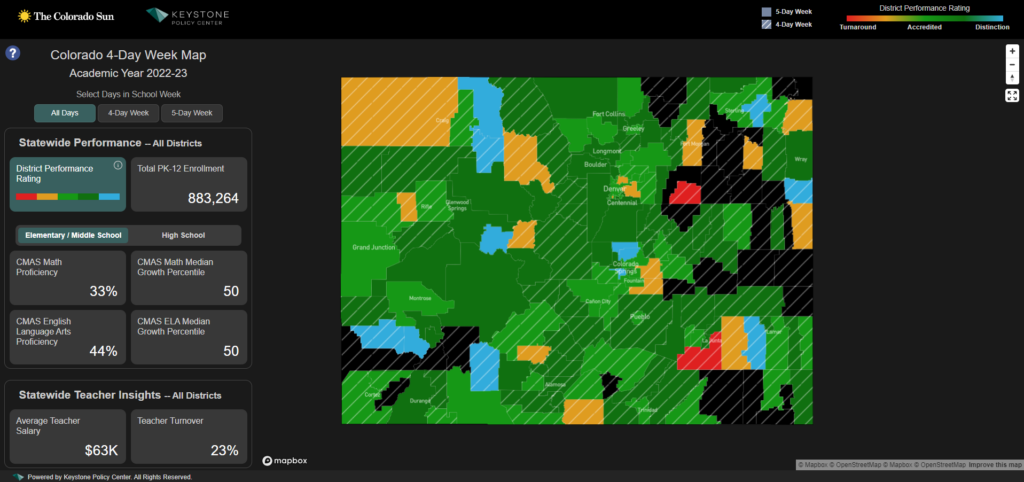Overview:
In “Doing Less with Less: How a four-day school week affects student learning and the teacher workforce,” Keystone Policy Center provides both a quantitative and qualitative examination of Colorado’s four-day school week phenomenon.
The first four-day districts came online in Colorado in the early 1980s, after the state legislature passed a law allowing more calendar flexibility for public schools. Since then, the phenomenon has grown steadily, mostly in small, rural districts. Some districts have added hours to each school day to meet state minimum requirements of 1,080 hours in school per year. Others have pared down school time to be closer to that annual minimum.
The four-day trend shows signs of spreading to larger districts as well. Pueblo City 60, a district of 15,000 kids, went to a four-day week in 2018-19. And starting with that same school year, Brighton 27J, just northeast of Denver, with just over 23,000 students, became the largest school district in the country to switch to a four-day week.
In interviews with superintendents across Colorado, recruiting and retaining teachers emerged as far and away the biggest factor for switching to a four-day week. Almost no one said the change was necessarily in the academic interest of students. Some argued that the effect on academic achievement has been negligible, and said that the positive impact on student mental health has outweighed any academic concerns. Initial hopes that cutting the number of days would result in budget savings proved to be a chimera.
The report gives a brief review of national research on the four-day school week movement. Next, using Colorado Department of Education data, it delves into the impacts on student achievement, teacher talent, and enrollment. It then explores how the four-day school week has affected districts in rural southwestern Colorado and in the Denver metro area, focused on Brighton 27J and its neighbor to the west, Adams 12.
Finally, the report discusses policy implications of the findings, as well as some recommendations. The four-day school week has strong proponents and detractors, and (spoiler alert) the data in Colorado gives neither side a clear upper hand (although national research is more conclusive).
Summary of Recommendations
Doing Less with Less provides some useful recommendations for examining the practice of a four-day school week:
- The Colorado Department of Education should create a panel composed of experts and stakeholders to investigate and provide recommendations around the four-day school week. The panel’s work would be to ensure that all students whether in four-day or five-day school districts are receiving the support necessary to enable them to meet the state’s education standards.
- Create a rigorous process for state approval of four-day school weeks, with the core question being whether this change will improve student outcomes. The process should not, as is currently the case, be a rubber stamp without a review of the impacts on student learning.
- Study how instructional time is used to enable students to reach state standards in four- and five-day instructional settings. Are there best practices for use of instructional time for different grades and content in four-and five-day contexts? ? What are these and how are Colorado school districts using them?
- Provide examples of best practices and support in fifth-day programming for districts using a four-day week. Should districts be required to provide programming on the fifth day and should it be educational? If so, what are the standards for this programming?
Interactive Map
Keystone has also published an interactive data map, in partnership with the Colorado Sun, to accompany this report. The map details the academic performance, enrollment, CMAS scores, average teacher salary, and teacher turnover throughout the state. The map also highlights which districts utilize a four- or five-day school week. Click the image below to access the map.



 Steven Williams is the Chief Executive Officer of PepsiCo North America, overseeing a more than $48 billion business that spans PepsiCo’s Foods and Beverage operating units. His leadership encompasses more than 125,000 associates and over 900 locations across the U.S. and Canada. Steven joined PepsiCo in 2001 as part of PepsiCo’s acquisition of the Quaker Oats Company, which he joined in 1997, and has held leadership positions of increased responsibility since.
Steven Williams is the Chief Executive Officer of PepsiCo North America, overseeing a more than $48 billion business that spans PepsiCo’s Foods and Beverage operating units. His leadership encompasses more than 125,000 associates and over 900 locations across the U.S. and Canada. Steven joined PepsiCo in 2001 as part of PepsiCo’s acquisition of the Quaker Oats Company, which he joined in 1997, and has held leadership positions of increased responsibility since.


